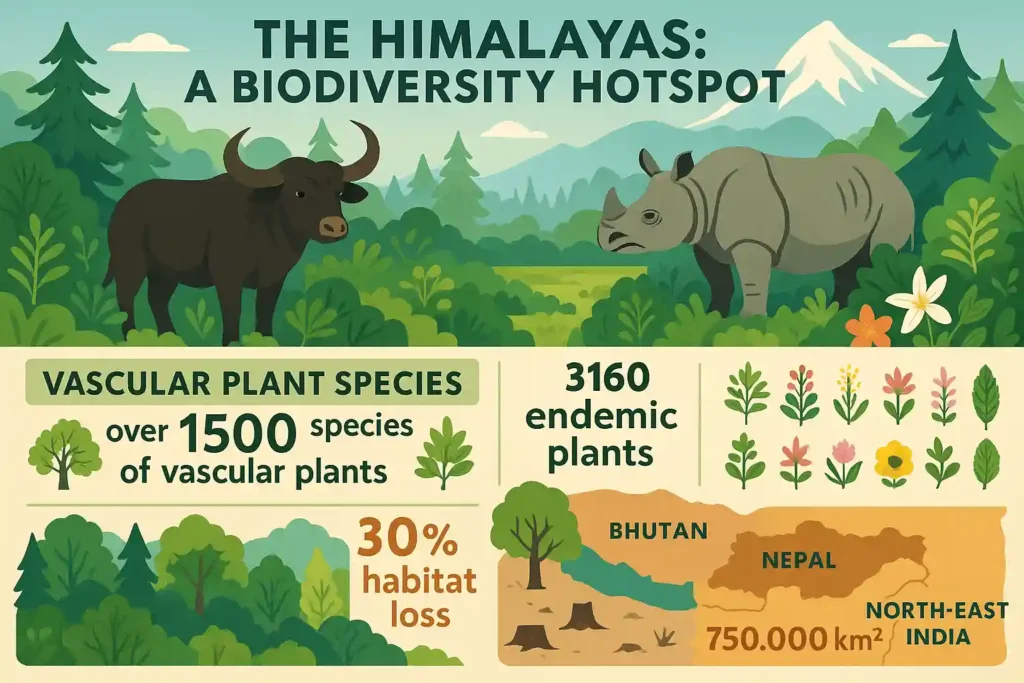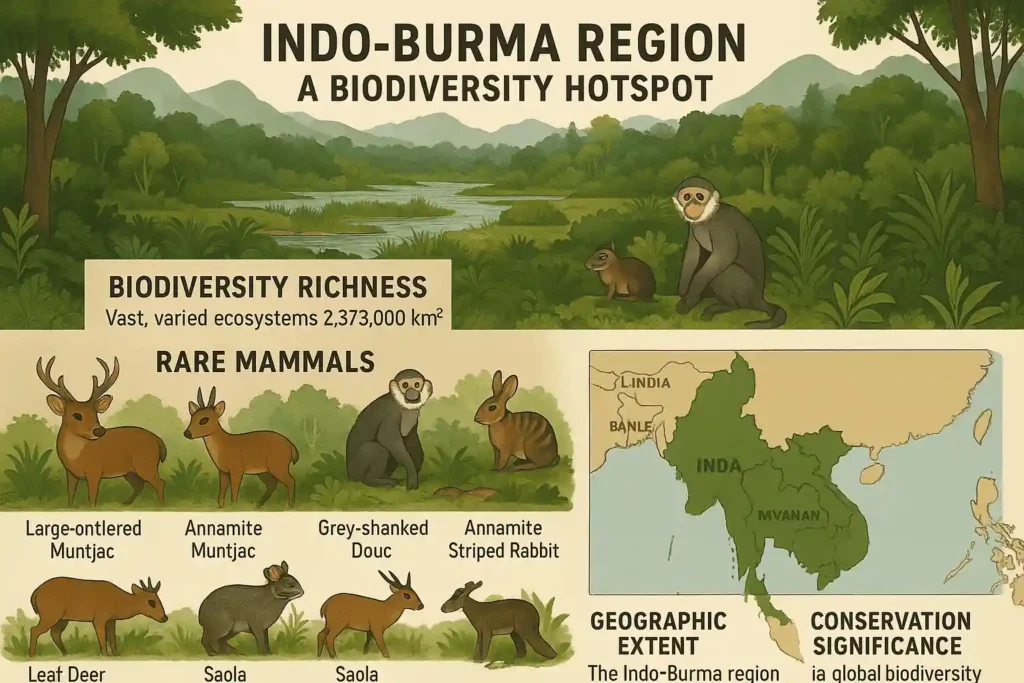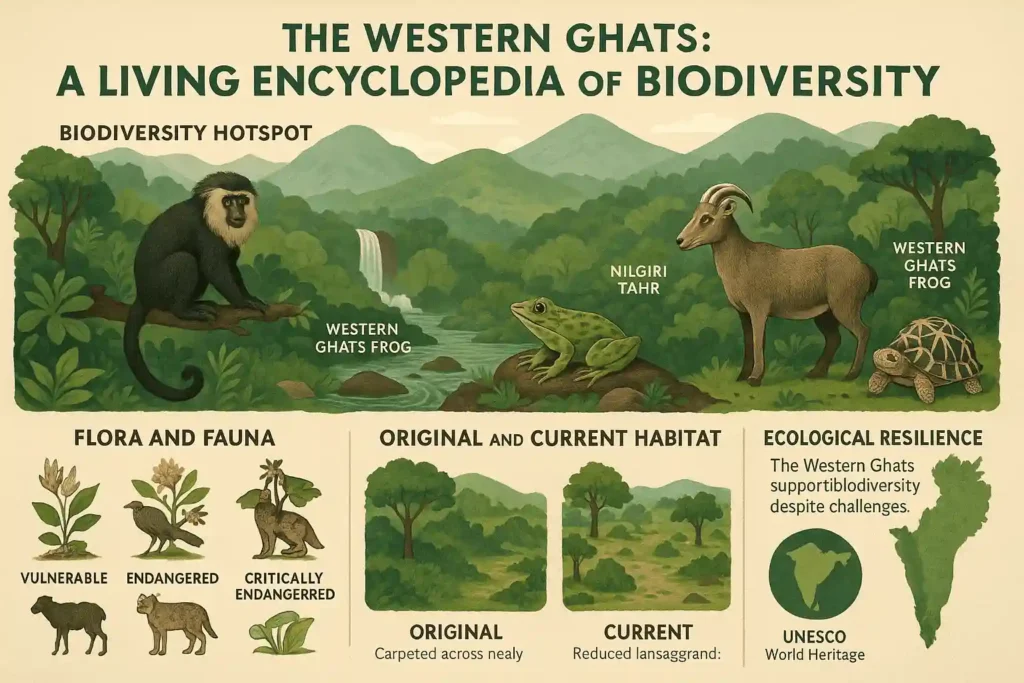When I first explored the concept of biodiversity, I was struck by the immense variation across India’s landscapes from dense forests filled with towering trees to remote areas teeming with rare animal and plant species. This incredible natural wealth, marked by both species richness and species evenness, places India among the world’s most rich nations in terms of biological diversity. Covering just 2.4% of the world’s geographical area, it holds nearly 8% of all recorded species, making it a crucial subject for anyone preparing for the IAS Exam.
The concept of Biodiversity Hotspots, coined by Norman Myers, specifically highlights regions with extremely high species richness and significant endemism — a key element in the UPSC Mains syllabus under GS-III. The four recognized biodiversity hotspots in India—the Himalayas, the Western Ghats, the Indo-Burma region, and Sundaland—are central to conservation debates, especially with many endangered species identified by IUCN being found there.
For aspirants, consolidating this topic into organized notes or a downloadable PDF aligned with the UPSC CSE Syllabus can simplify complex aspects of ecology. This article serves as a gateway to understanding the importance of these ecological treasures from both an academic and environmental perspective.
Table of Contents
Biodiversity Hotspots – 2 Main Qualifying Criteria
The Himalayas
During my trek across the Himalayas, particularly through North-East India, I was struck not just by the sheer altitude of this iconic mountain range but by its role in shaping biodiversity hotspots in India. Recognized by Conservation International, this region meets two critical requirements to qualify as a hotspot—it houses over 1500 species of vascular plants, showcasing a high degree of endemism, and it has lost more than 30% of its original habitat, rendering it threatened.

From the elusive Wild Asian Water Buffalo to the famed One-horned Rhino, this stretch—spanning parts of Bhutan, Nepal, and North-East India—boasts over 10,000 species of flora, including 3160 endemic plant species across a vast 750,000 km2. As an ecologist, seeing such concentration of endangered species reinforced how fragile yet invaluable these ecosystems are.
Indo – Burma Region
Exploring the dense biodiversity of the Indo-Burma Region, I was equally fascinated by the staggering variety spread across 2,373,000 km². This hotspot isn’t just a statistical marvel—it’s home to rare large mammal species like the Large-antlered Muntjac, Annamite Muntjac, Grey-shanked Douc, Annamite Striped Rabbit, Leaf Deer, and the mysterious Saola.

The Indo-Burma zone, much like the Western Ghats and Sundaland, forms the core of India’s biodiversity narrative. With each step into its terrain, it becomes evident how critical these regions are—not just for conservationists but for anyone invested in our planet’s ecological future.
The Western Ghats
While preparing for a deep-dive workshop on geography, I revisited the Western Ghats, a treasure trove nestled along the western edge of peninsular India—one of those rare regions where every trail feels like walking through time and evolution. As per UNESCO, this biodiverse stretch is home to hundreds of globally threatened species—from plant, mammal, bird, and amphibian to reptile and fish—making it a living encyclopedia for curious aspirants in biodiversity preparation.

Originally carpeted with vegetation across nearly 190,000 km2, this landscape of deciduous and rain forests has been dramatically reduced, yet continues to support flora and fauna that are now classified as Vulnerable, Endangered, or even Critically imperiled, reminding me why the Ghats aren’t just a hotspot on paper, but a beating heart of ecological resilience.
Sundaland
During my travels across Southeast Asia, I was captivated by the incredible ecological diversity of Sundaland, a hotspot that stretches across Singapore, Thailand, Indonesia, Brunei, and Malaysia. Declared a World Biosphere Reserve in 2013 by the United Nations, this region has become a global reference point for conservationists like me who study the balance of terrestrial and marine ecosystem dynamics.
What struck me most was the sheer number of vascular plants—a staggering 25,000 species, 15,000 of which are exclusively found here—making Sundaland one of the most biologically richest zones on the planet. Every inch of this landscape breathes life and offers insight into how irreplaceable such biodiversity truly is.
Freshwater Turtle Species & Birds
In a hotspot teeming with life, the presence of endemic freshwater turtle species paints a sobering picture, as many inch closer to extinction due to over-harvesting and escalating habitat loss. This fragile balance isn’t exclusive to turtles; the skies, too, are home to rare bird species like the threatened White-eared Night-heron, the elusive Grey-crowned Crocias, and the striking Orange-necked Partridge, all silently signaling the urgent need to protect such invaluable biodiversity.
Why are Biodiversity Hotspots important?
Biodiversity is the foundation of all life on Earth, forming an ecosystem that enables us to breathe clean air, drink pure water, and eat nourishing food. These hotspots are more than just dense clusters of species—they represent a delicate balance where human society and nature coexist, drawing from living resources and natural resources alike. Acting as our planet’s ecological life support system, they ensure continuity not just for wildlife, but for our own survival and wellbeing as well.
| Read More How many AIIMS in India List 2025 |
Biodiversity in India – Flora, and Fauna
India is home to incredibly rich flora and fauna, harboring a diverse range of species spread across various habitat types shaped by unique climate and topology. The Zoological Survey of India, based in Kolkata, plays a vital role in documenting the country’s faunal resources, which include thousands of mammals, birds, and insects. When it comes to plant species, India ranks among the top in the world, housing over 18,000 flowering plants across distinct floristic regions like the Western Himalayas, Eastern Himalayas, Indus, Ganges, Assam, Deccan, Malabar, and the Andaman Islands.
Diverse ecosystems such as tropical rainforest in the Western Ghats, northeast India, and Andaman, deciduous forests of the eastern, central, and southern belts, and coniferous forests of the Himalayas, together contribute to the extraordinary wealth of Indian plant species found in the forests.
Endangered Species of India
In India, the International Union for Conservation of Nature plays a pivotal role in tracking the status of species, both plants and animals, that face the ever-growing risk of extinction. The country’s rich biodiversity includes numerous flora and fauna that have been recorded as critically endangered, signaling a shrinking population and deteriorating habitat conditions. Drawing from years of research and field observations, I’ve seen firsthand how these vulnerable species highlight urgent conservation needs to prevent them from becoming completely extinct.
What is the IUCN Red List?
The IUCN Red List, also known as the Red Data List, was established in 1964 to provide a comprehensive evaluation of the biological species worldwide that face the threat of extinction. Over 77,300 species have been rigorously assessed to determine their conservation status, categorizing them based on the level of risk they face. These categories range from Extinct and Extinct in the wild, where species survive only in captivity or outside their historic range, to Critically endangered, Endangered, and Vulnerable — all indicating varying degrees of endangerment in the wild.
For those preparing for the IAS prelims exam or UPSC, understanding the criteria and status of animals on this list is essential, as it frequently appears in objective-type questions. The list also includes species classified as Near Threatened, Least concern — which represents the most abundant taxa — as well as Data Deficient and Not evaluated categories for species lacking sufficient information.
Tiger Conservation in India
The conservation of the tiger in India has been a critical focus, especially as this endangered species faces increasing threats. Since the Government of India launched Project Tiger in April 1973, administered by the National Tiger Conservation Authority, efforts have centered on protection to prevent extinction and preserve areas of biological importance and natural heritage.
The major threats to tiger survival include man-animal conflict, hunting, poaching, illegal trade, habitat loss, and decline of prey species. Despite these challenges, the population rose to 2,967 in 2018, according to a comprehensive survey covering over 381,400 km of forested habitats across 20 states and numerous tiger reserves.
For aspirants preparing for the UPSC civil service exam, understanding tiger conservation is crucial, as it connects to biodiversity, hotspot preservation, environment, and ecology—all key topics in the UPSC Mains Syllabus. Awareness of the national level and global level actions and initiatives, including those addressing climate change, enriches the perspective needed for descriptive answers in the written paper. These developments underscore the ongoing commitment to maintaining India’s rich wildlife heritage and safeguarding its iconic tiger population.



